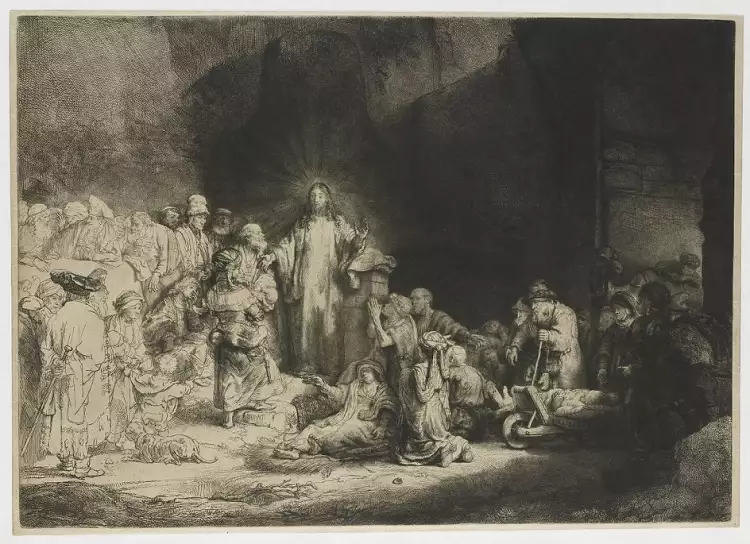
Etching is a type of engraving and printing technique
Etching is a type of metal engraving, an ancient deep printing technique using the acid-etching method on printing plates. The etching technique allows for the production of a large number of high-quality impressions (prints) on paper from etched plates.
 Etching. Daniel Hopfer. Three Landsknechts, 1530
Etching. Daniel Hopfer. Three Landsknechts, 1530
Distinctive features and a brief history of etching
Etching emerged in the early 16th century in Germany as an alternative technique for creating printing plates. In the traditional method of plate processing, the artist had to exert significant pressure with a burin on the metal to achieve a detailed image.
 Etching. John Ingram. The Game of Chinese Chess, 1741-1763
Etching. John Ingram. The Game of Chinese Chess, 1741-1763
Etching is done by pre-treating the plate with acid-resistant varnish. This significantly simplifies the process of creating a drawing. The engraver processes the varnish layer with minimal physical effort using a cutting tool, and then acid etches the metal to the desired depth.
Thanks to the use of this new technique, artists were able to create more expressive images on solid metal. This allowed for the transmission of various tonal shades in the printed impression.
 Etching. Jacques Callot. The Large Hunt
Etching. Jacques Callot. The Large Hunt
The first artistic etchings, produced in Augsburg by Daniel Hopfer, date back to the year 1501. Shortly thereafter, the prominent Renaissance painter Albrecht Dürer became fascinated with this new form of printmaking. He created numerous magnificent engravings on steel and copper plates.
But the art of etching reached its peak popularity in the 17th century in the Netherlands. A significant contribution to the development of this type of graphic art was made by Rembrandt Harmenszoon van Rijn. In France, around 1500 engravings were created by Jacques Callot, while in Italy, notable etching masters included Guido Reni and José Ribera.
 Etching. Rembrandt. Hundred Guilder Print, 1643-1649
Etching. Rembrandt. Hundred Guilder Print, 1643-1649
At the turn of the 18th and 19th centuries, Francisco Goya produced several series of famous engravings. Subsequently, prominent Impressionist artists often turned to this graphic technique in their creative endeavors:
- Claude Monet.
- Camille Pissarro.
- Auguste Renoir.
- Paul Cézanne.
In the 20th century, with the development of the chemical industry, it became possible to replace toxic components with less harmful etching substances: beeswax and acrylates.
 Etching. Francisco José de Goya y Lucientes. From the Disasters of War Series, 1810-1820
Etching. Francisco José de Goya y Lucientes. From the Disasters of War Series, 1810-1820
On the Very Important Lot portal, you can participate in auctions to acquire engravings, paintings, and antiques. Collectors also buy works directly from contemporary artists here.
 Caspar David Friedrich is the most famous and melancholic romanticist of German painting
Caspar David Friedrich is the most famous and melancholic romanticist of German painting  The painting "The Burning of the Houses of Lords and Commons" by William Turner is a dramatic depiction of a historical event
The painting "The Burning of the Houses of Lords and Commons" by William Turner is a dramatic depiction of a historical event  Auction: essence, types, history, the most famous art auctions
Auction: essence, types, history, the most famous art auctions  English Silver Tableware - History, Fashion, and Styles
English Silver Tableware - History, Fashion, and Styles  Neoclassicism: once again, an alignment with ancient ideals!
Neoclassicism: once again, an alignment with ancient ideals!  Ceramics as Fine Art: The Evolution from Craft to High Culture
Ceramics as Fine Art: The Evolution from Craft to High Culture  Romanticism: Wings of Freedom and Inspiration
Romanticism: Wings of Freedom and Inspiration  Golden Age of Dutch painting - an era that gave the world the finest masterpieces of Dutch art of all times
Golden Age of Dutch painting - an era that gave the world the finest masterpieces of Dutch art of all times  Wettmann Onlineauctionen: A Portal to Rare Antiques and Luxurious Treasures
Wettmann Onlineauctionen: A Portal to Rare Antiques and Luxurious Treasures  Fashion Photography - the Dazzling World of Fashion, Models, and Glossy Magazines
Fashion Photography - the Dazzling World of Fashion, Models, and Glossy Magazines